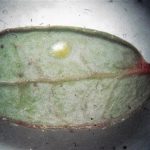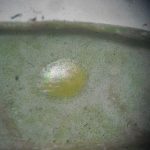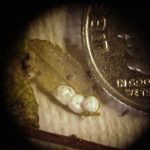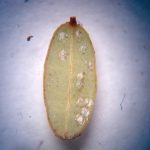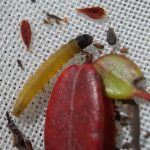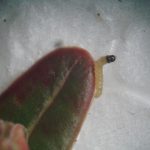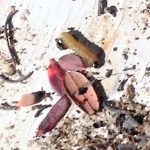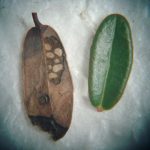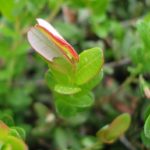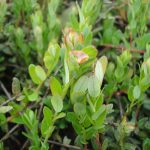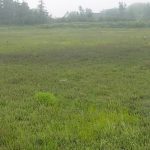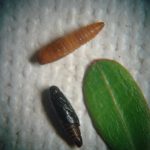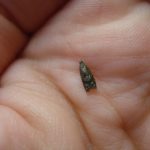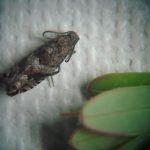Blackheaded Fireworm
- Blackheaded fireworm egg
- Blackheaded fireworm eggs on cranberry leaves (ordinarily a single leaf would not have multiple eggs on it, but the moths were held in captivity with very few leaves at their disposal)
- Closer view of the Blackheaded fireworm egg shown in the adjacent (left) photo
- A pair of Blackheaded fireworm eggs on the underside of a cranberry leaf
- Three hatched/empty blackheaded fireworm eggs
- Empty Blackheaded fireworm eggs on the underside of a cranberry leaf (7/20/16); the moth that deposited the eggs was in captivity with only a few cranberry uprights/leaves at her disposal.
- Blackheaded fireworm larva (full-sized; final instar)
- Blackheaded fireworm larva
- A 1st-generation blackheaded fireworm larva, downeast Maine – June 17th, 2019. Look for the shiny black head to help with identification.
- Cranberry leaves damaged by Blackheaded fireworm larvae (they feed by skeletonizing the leaves)
- A fireworm-damaged cranberry leaf (left) next to an undamaged cranberry leaf (right)
- Two cranberry leaves with feeding injury from Blackheaded fireworm larvae
- A cranberry tip occupied by a Blackheaded fireworm larva (in Maine, be watchful for this in June each year)
- Cranberry tips pulled/webbed together and occupied by a Blackheaded fireworm larva
- Another example of some cranberry tips pulled and webbed together by a Blackheaded fireworm larva (some frass is also visible in this picture: little black droppings that are visible on the lower leaves)
- Another cranberry tip damaged by a Blackheaded fireworm larva hidden between the leaves
- A cranberry bed with a noticeable dark area that was ravaged by Blackheaded fireworm larvae (2nd-generation larvae) (photographed August 20th – downeast Maine) (be watchful in July and August for the 2nd generation of larvae)
- A pair of Blackheaded fireworm pupae (photographed June 21st in central Maine)
- Blackheaded fireworm adult/moth (they are quite small)
- A Blackheaded fireworm moth (picture taken June 22nd – central Maine)
photos by C. Armstrong
Description:
Adults / Moths: The adults are very small, only about 1/4-inch in length, dark in color, with alternating light and dark gray-brown bands on their forewings. They are active at dusk, and can be seen hovering freely just above the vines. They will occasionally fly during the day if it is cloudy and warm or if they are disturbed. Female moths begin laying eggs within a day of emergence from their pupae. Typically by mid to late July (in Maine), a second generation of caterpillars begins, and this leads to a 2nd-generation of moths that emerge and then lay a new generation of eggs (in some years, a third generation of larvae may thus be possible, but generally the second generation of eggs are the ones that subsequently overwinter before hatching into 1st-generation larvae the following May or early June).
Eggs: Eggs that are oviposited by the final generation of moths overwinter and begin to hatch in May (average over the years puts the first hatching at around May 24th for most of Maine). The hatching period may continue for three to six weeks, varying some according to temperature (colder weather will extend the period). Eggs laid by the ensuing moths begin to hatch usually in mid-July (sometimes end of June in warmer summers or in warmer locations like southern Maine and Massachusetts). Each egg is laid singly on the underside of the cranberry leaves and has a flat, disklike shape. They are extremely small (1/32-inch in diameter) and yellow in color, unless they have already emerged as in the case of the three empty eggshells pictured above which are white.
Larvae: (mid to late May until mid to late-June, and again starting generally in mid to late July when a 2nd-generation begins) — The damaging stage of the blackheaded fireworm is the larval stage. Larvae are green-yellow or pale yellow, and their heads are black and shiny (see photos above). When mature (two to three weeks after hatching), they measure roughly 1/3-inch in length. There are two separate generations of larvae (maybe even three) each season, and the 2nd generation is the more damaging one since their numbers are normally much greater (each mated female moth can lay upwards of 200 eggs). Cranberry leaves that are consumed by fireworm results in fewer nutrients available for nourishing and growing the berries.
Monitoring and Control: In addition to sweep-net scouting, spend some time visually scanning for upright tips with terminal leaves that have been webbed tightly together! Break off any tip of that sort, and carefully tease apart the terminal leaves. If a small larva suddenly squirms out, wriggling backwards and possibly right across your hand and down to the ground (often attached to a strand of silk)…and if this happens before you’ve even blinked, then you’ve probably encountered a fireworm larva. You should then sweep, if you haven’t already, to see if you pick up any in your net. They do not get picked up in sweeps very easily, so if you average even one larva per 25 sweeps, you may well be justified in taking action (depending on your history with this pest, your expected crop value, etc.). View the Maine Cranberry Pest Management Guide for a list of the currently available pesticide products for controlling them, and for the most current recommended Action Threshold (AT) to consider following for triggering a spray or possibly a larval-drowning flood (the traditional AT is just 1 to 2 larvae per 25 sweeps). Infestations of 2nd-generation larvae are far more dangerous, because their numbers are much higher, especially, of course, if any 1st-generation populations are left uncontrolled. Infestations of both generations are usually patchy, at least at first, and larvae tend to be more numerous along edges. Spot-treatment is desirable in such cases. Sweepnet-captured ‘First Dates’ for 1st-generation larvae: 6/12/06, 5/25/07, 5/14/08, 5/14/09, 5/16/13, 5/20/14, 5/27/17, 5/21/18, 6/5/19 (Average of these = May 24th); See also the Pest Report each year for news of Maine’s first detection of 1st-generation fireworm larvae.

